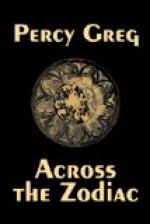The twilight to north and south extended on the image
of the Earth deep into that part on which as yet the
Sun was below the horizon, and consequently daylight
faded into darkness all but imperceptibly, save between
the tropics. We watched long and intently as
league by league new portions of Europe and Africa,
the Mediterranean, and even the Baltic, came into view;
and I was able to point out to Eveena lands in which
I had traveller, seas I had crossed, and even the
isles of the Aegean, and bays in which my vessel had
lain at anchor. This personal introduction to
each part of the image, now presented to her for the
first time, enabled her to realise more forcibly than
a lengthened experience of astronomical observation
might have done the likeness to her own world of that
which was passing under her eyes; and at once intensified
her wonder, heightened her pleasure, and sharpened
her intellectual apprehension of the scene. When
we had satiated our eyes with this spectacle, or rather
when I remembered that we could spare no more time
to this, the most interesting exhibition of the evening,
a turn of the machinery brought Venus under view.
Here, however, the cloud envelope baffled us altogether,
and her close approach to the horizon soon obliged
the director to turn his apparatus in another direction.
Two or three of the Asteroids were in view. Pallas
especially presented a very interesting spectacle.
Not that the difference of distance would have rendered
the definition much more perfect than from a Terrestrial
standpoint, but that the marvellous perfection of
Martial instruments, and in some measure also the rarity
of the atmosphere at such a height, rendered possible
the use of far higher magnifying powers than our astronomers
can employ. I am inclined to agree, from what
I saw on this occasion, with those who imagine the
Asteroids to be—if not fragments of a broken
planet which once existed as a whole—yet
in another sense fragmentary spheres, less perfect
and with surfaces of much greater proportionate irregularity
than those of the larger planets. Next was presented
to our view on a somewhat smaller scale, because the
area of the chamber employed would not otherwise have
given room for the system, the enormous disc and the
four satellites of Jupiter. The difference between
400 and 360 millions of miles’ distance is,
of course, wholly unimportant; but the definition
and enlargement were such that the image was perfect,
and the details minute and distinct, beyond anything
that Earthly observation had led me to conceive as
possible. The satellites were no longer mere
points or tiny discs, but distinct moons, with surfaces
marked like that of our own satellite, though far less
mountainous and broken, and, as it seemed to me, possessing
a distinct atmosphere. I am not sure that there
is not a visible difference of brightness among them,
not due to their size but to some difference in the
reflecting power of their surfaces, since the distance




